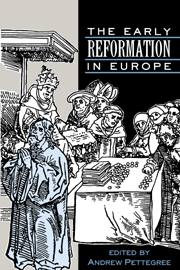5 - Scandinavia
Published online by Cambridge University Press: 06 January 2010
Summary
The Reformation in Scandinavia seems at first sight to have been a rare example in Europe of a relatively painless transition to a Lutheran state church. This, however, is a misleading impression, born of hindsight and an insufficient comprehension of the political and social complexities of this vast, if sparsely populated, area of northern Europe. The Reformation, in fact, took place within an unusually complex situation. Political and social instability dominated the period. The defeudalisation process of the late Middle Ages had brought lay and ecclesiastical aristocracy into conflict with peasants, burghers and the Crown. The 1520s and 1530s saw a succession of civil wars and revolts, some social or political in origin, others either in defence of Protestantism or specifically to oppose the new teaching. Only in the duchies of Schleswig and Holstein was the Reformation relatively unproblematic; in Denmark and Sweden its birth-pangs were significantly more painful.
The Union of the three Scandinavian kingdoms created in 1397 by the Danish Queen, Margrethe I, was by the sixteenth century on the point of collapse. This unwieldy entity, which included Denmark, Norway and Sweden, along with Finland and the duchies of Schleswig and Holstein, was finally brought down by the rebellion of the Swedish nobleman Gustav Vasa, which established Sweden as an independent kingdom in 1521. The revolt was a crushing blow for the Danish king, Christian II, whose arbitrary behaviour (including the execution of more than 80 leading members of the Swedish lay and ecclesiastical aristocracy in Stockholm in November 1520) had largely provoked the revolt.
- Type
- Chapter
- Information
- The Early Reformation in Europe , pp. 94 - 119Publisher: Cambridge University PressPrint publication year: 1992
- 2
- Cited by

